A previously unknown type of synapse appears to have been hiding in strange, hair-like appendages that can be found on the surfaces of neurons, new research reveals.
A study in mice suggests that structures called primary cilia play a role in neuronal signaling; specifically, they act as a shortcut for transmitting signals directly into the nucleus to trigger changes to chromatin, the complex that forms chromosomes.
This discovery may help scientists unravel the role of these mysterious structures in other cells, as well as give us a deeper understanding of the complicated workings of the brain.
"This special synapse represents a way to change what is being transcribed or made in the nucleus, and that changes whole programs," says doctor of medicine David Clapham of Howard Hughes Medical Institute's Janelia Research Campus.
"It is like a new dock on a cell that gives express access to chromatin changes, and that is very important because chromatin changes so many aspects of the cell."
Primary cilia can be found protruding from the surfaces of almost all mammalian cells – some of them have well-understood roles, like those helping move around mucus in our lungs – but in many cells, their functions are poorly understood.
In some cases, they can act as an antenna receiving signals from external stimuli. For instance, in photoreceptor cells, they play a role in processing light.
It's thought that primary cilia are a vestige from our unicellular origins, billions of years ago, but what function they serve in neurons has been something of a mystery.
That's at least partially because they are so small that they are hard to make out using traditional imaging techniques, the researchers say.
However, recent advances have made it easier to see smaller and finer structures, prompting a team led by neuroscientist Shu-Hsien Sheu of Janelia's Clapham Lab to take a closer look.
The researchers performed their study on both living adult mice and fixed brain specimens. They used focused ion beam-scanning electron microscopy to study the neurons in high resolution, determining that the cilia can form a synapse – a structure that allows neurons to exchange signals between cells – with neuron axons.
For the second stage of the research, researchers employed a newly developed biosensor in concert with a technique called fluorescence lifetime imaging (FLIM), to observe the biochemical processes taking place inside the cilia in living mice.
This allowed the team to break down a step-by-step process whereby the neurotransmitter serotonin is released from the axon onto receptors on the cilia. From there, a cascade of signals opens the chromatin in the neuron's nucleus, allowing changes to the genetic material inside.
The team is calling their discovery an "axo-ciliary synapse" or "axon-cilium" synapse, and says that, because the signals trigger changes in the cell nucleus, they could be responsible for implementing longer-term changes than the axon-dendrite synaptic connections.
The ciliary synapse may, therefore, be a shortcut to long-term genomic changes.
The next step in the research will be to take a closer look at other receptors on the neuronal primary cilia. This study only focused on serotonin, but there are at least seven more neurotransmitter receptors that warrant further investigation, the researchers say.
Following a deeper understanding of neuronal cilia, the team would like to investigate the role of primary cilia on other organs. A more detailed understanding of how the body works is always a good thing. It may lead to the development of more targeted, specialized therapeutic drugs, for example.
Although, of course, first it will need to be determined that the ciliary synapse is present and works the same way in human brains.
"Everything we learn about biology may be useful for people to lead better lives," Clapham says. "If you can figure out how biology works, you can fix things."
The research has been published in Cell.
